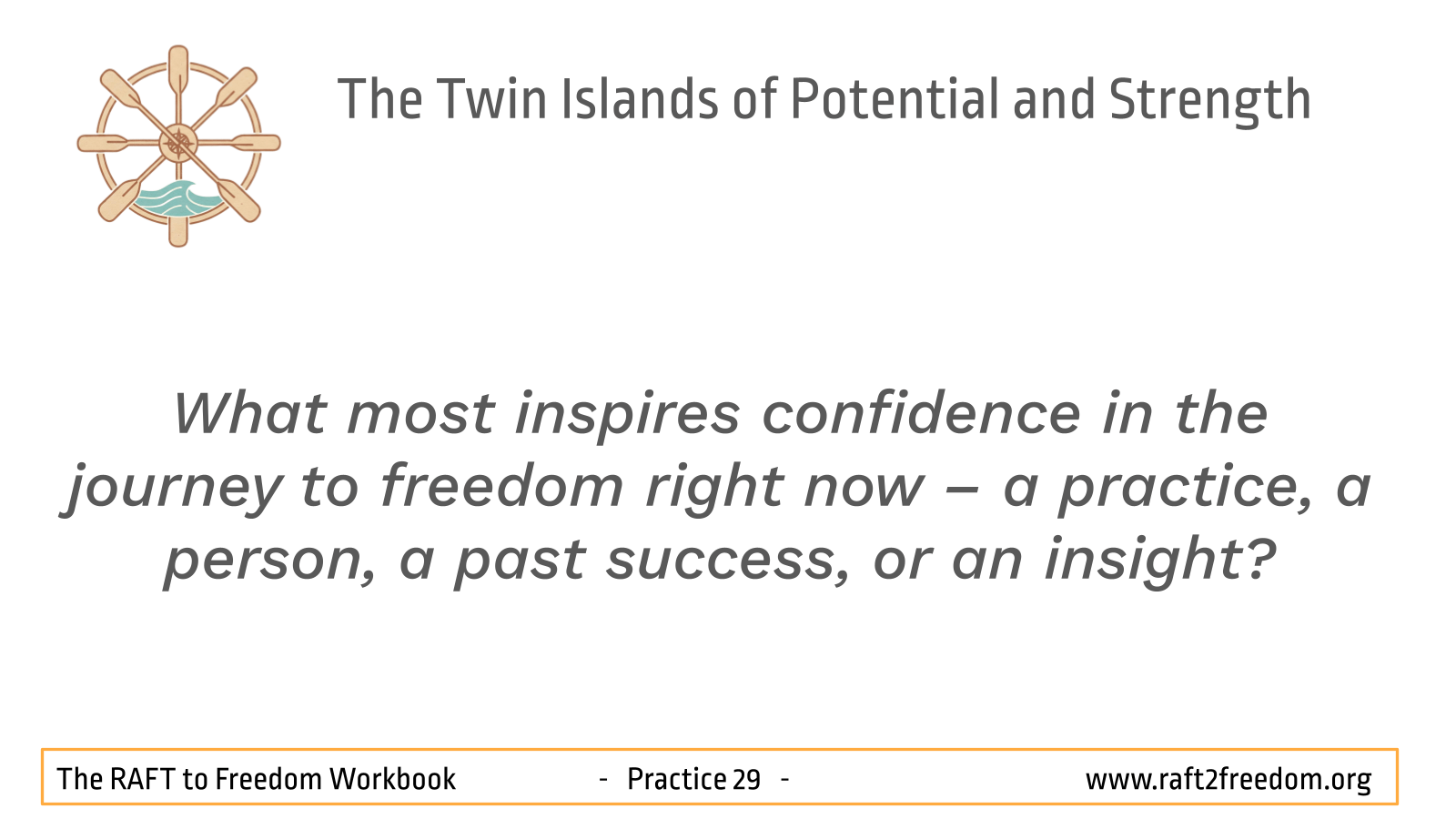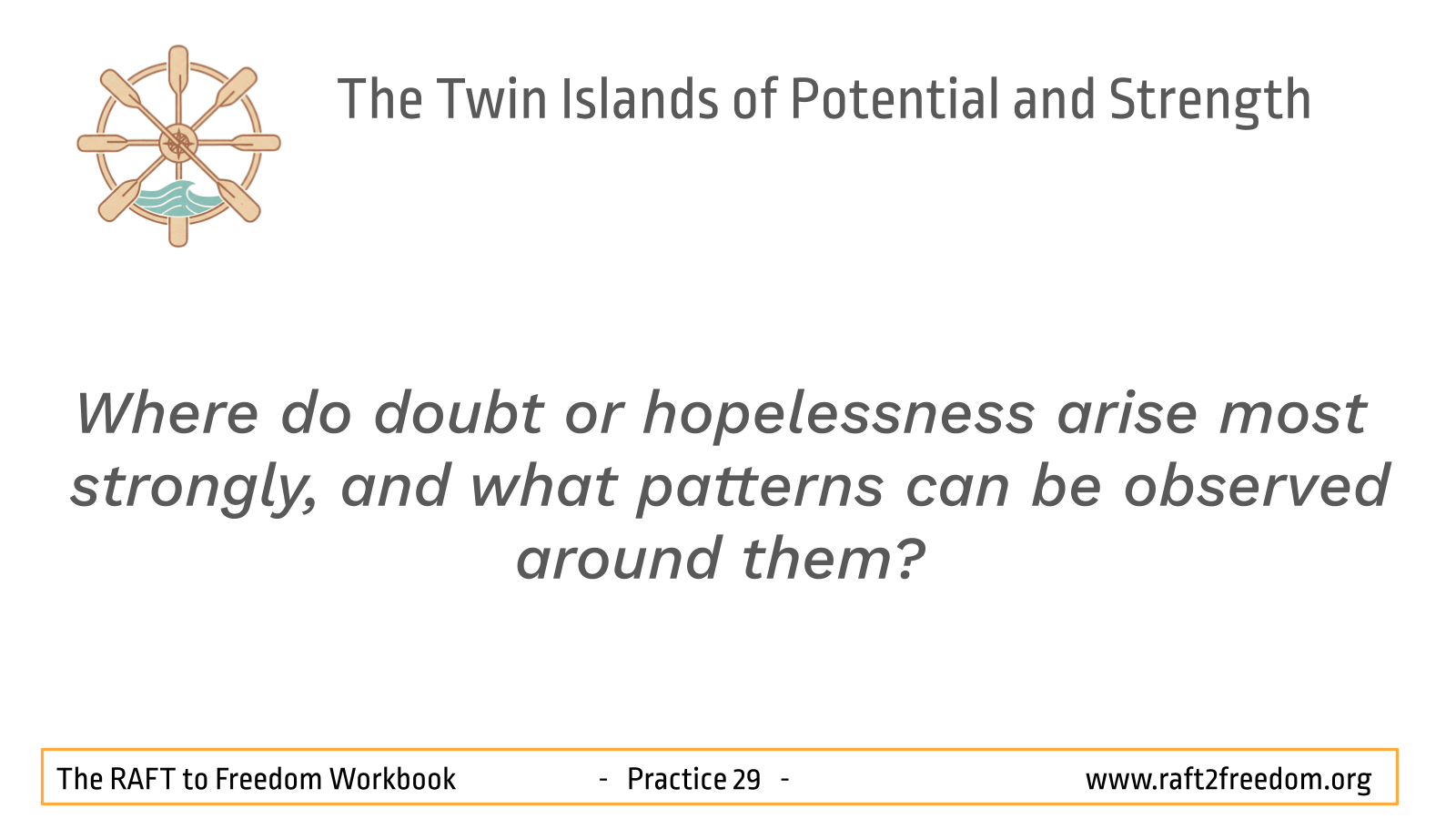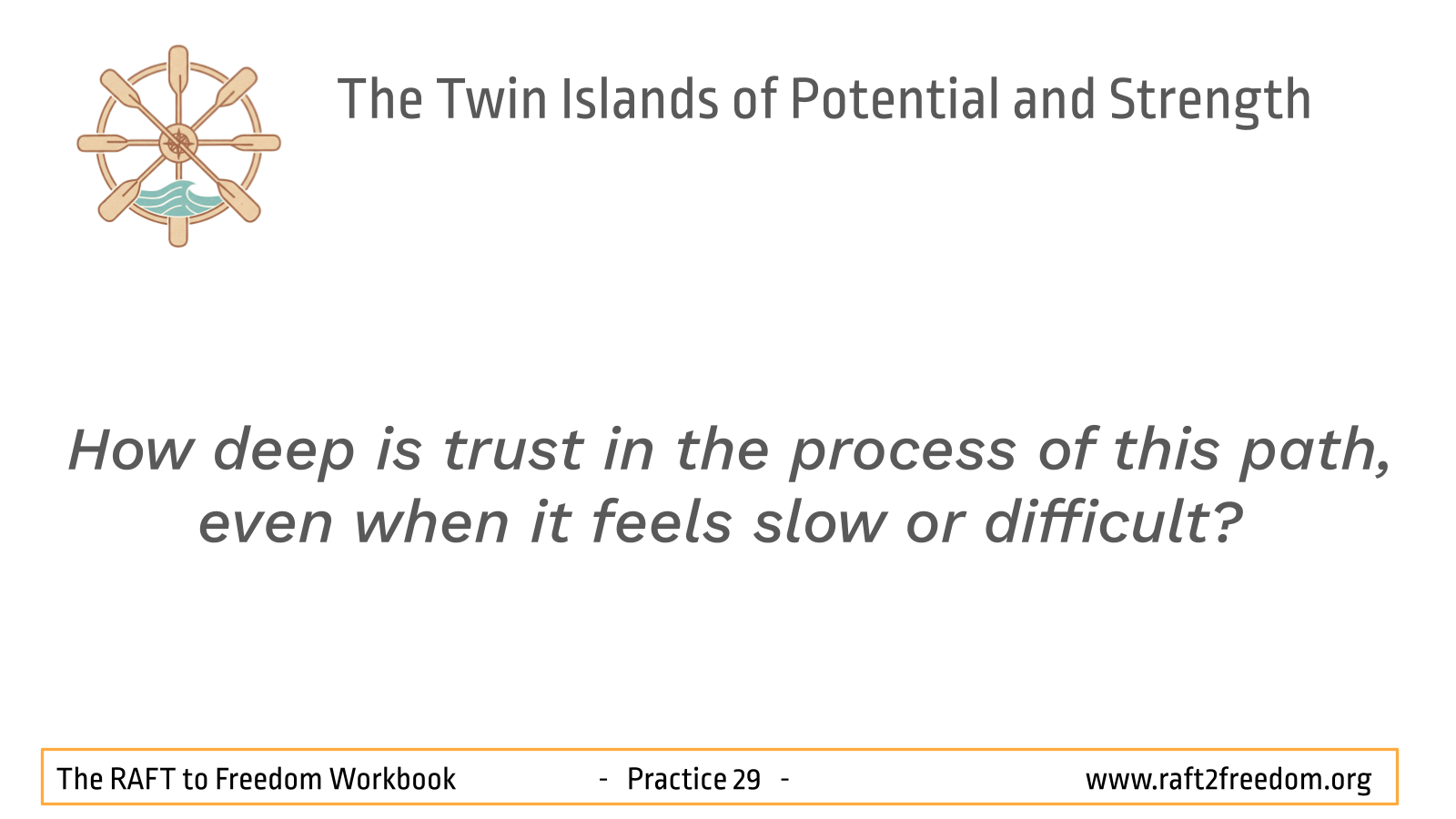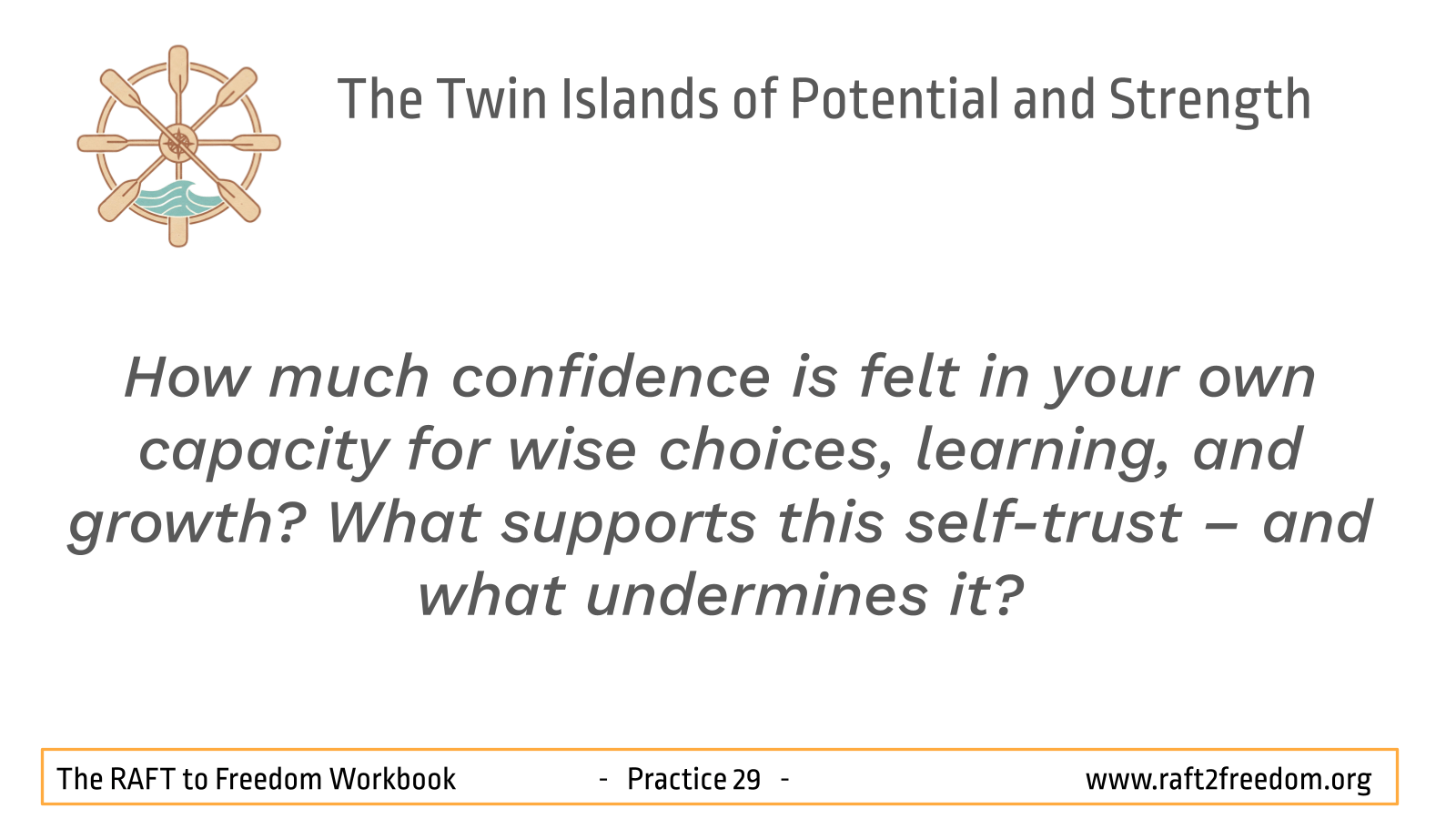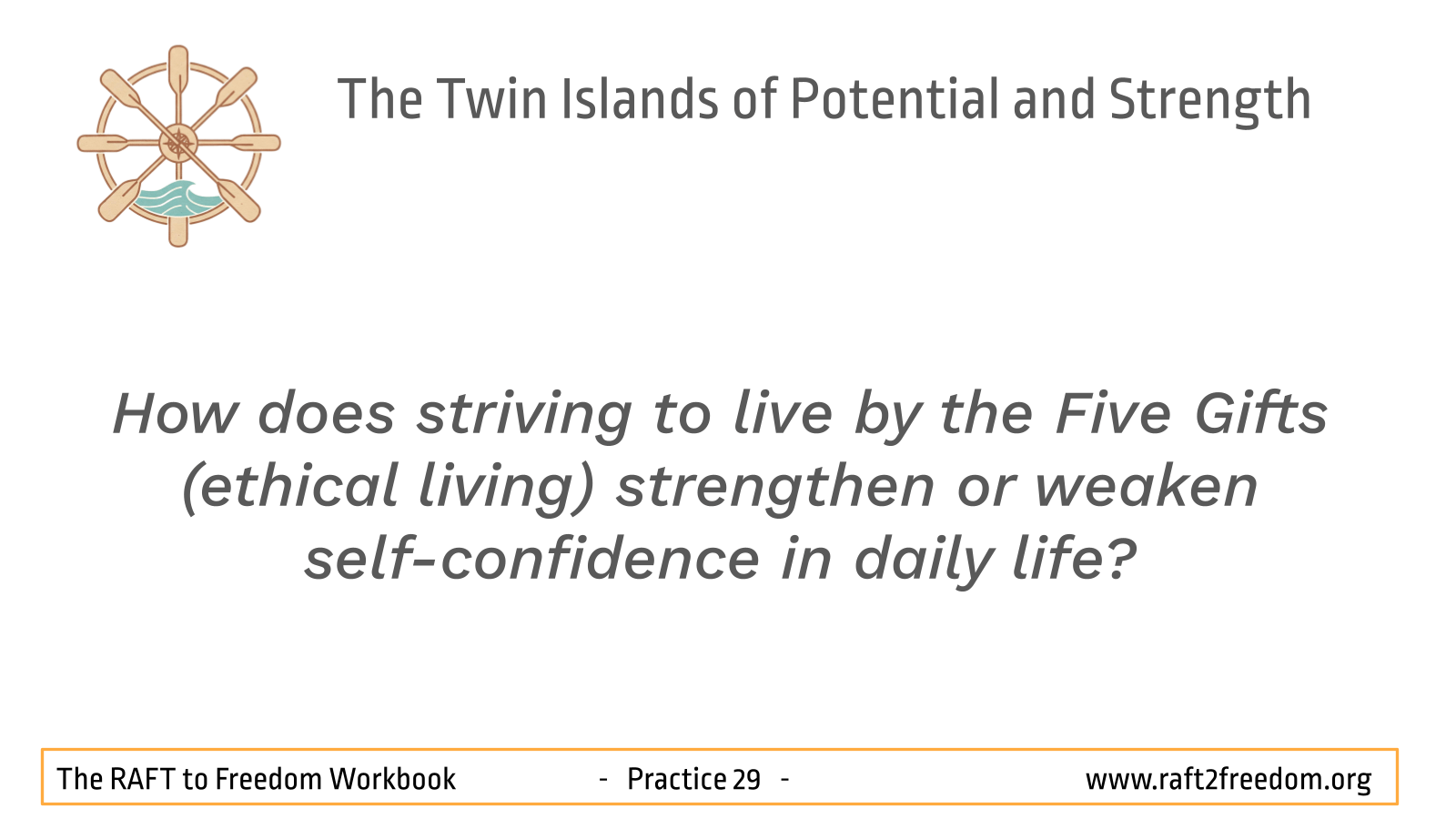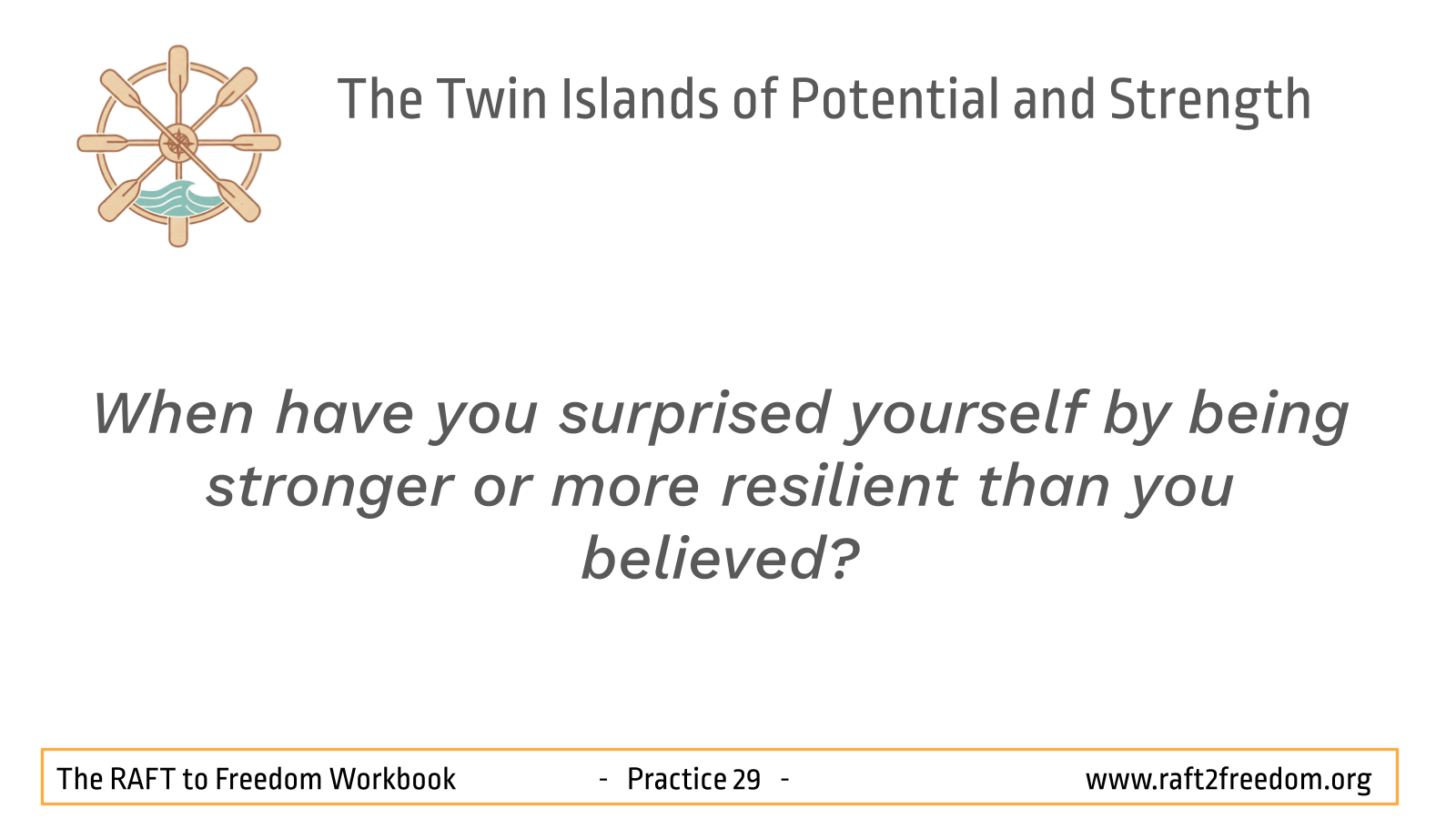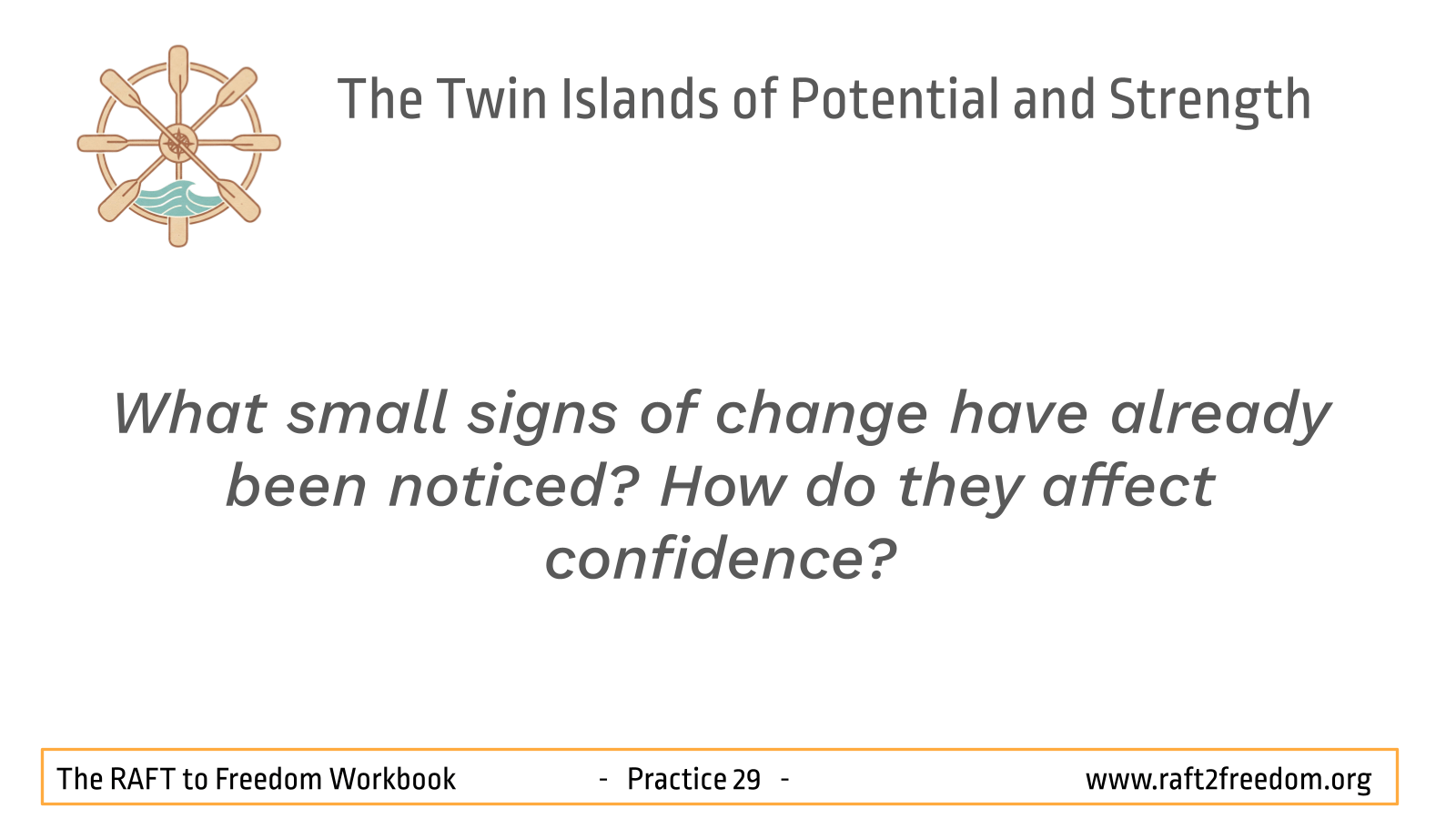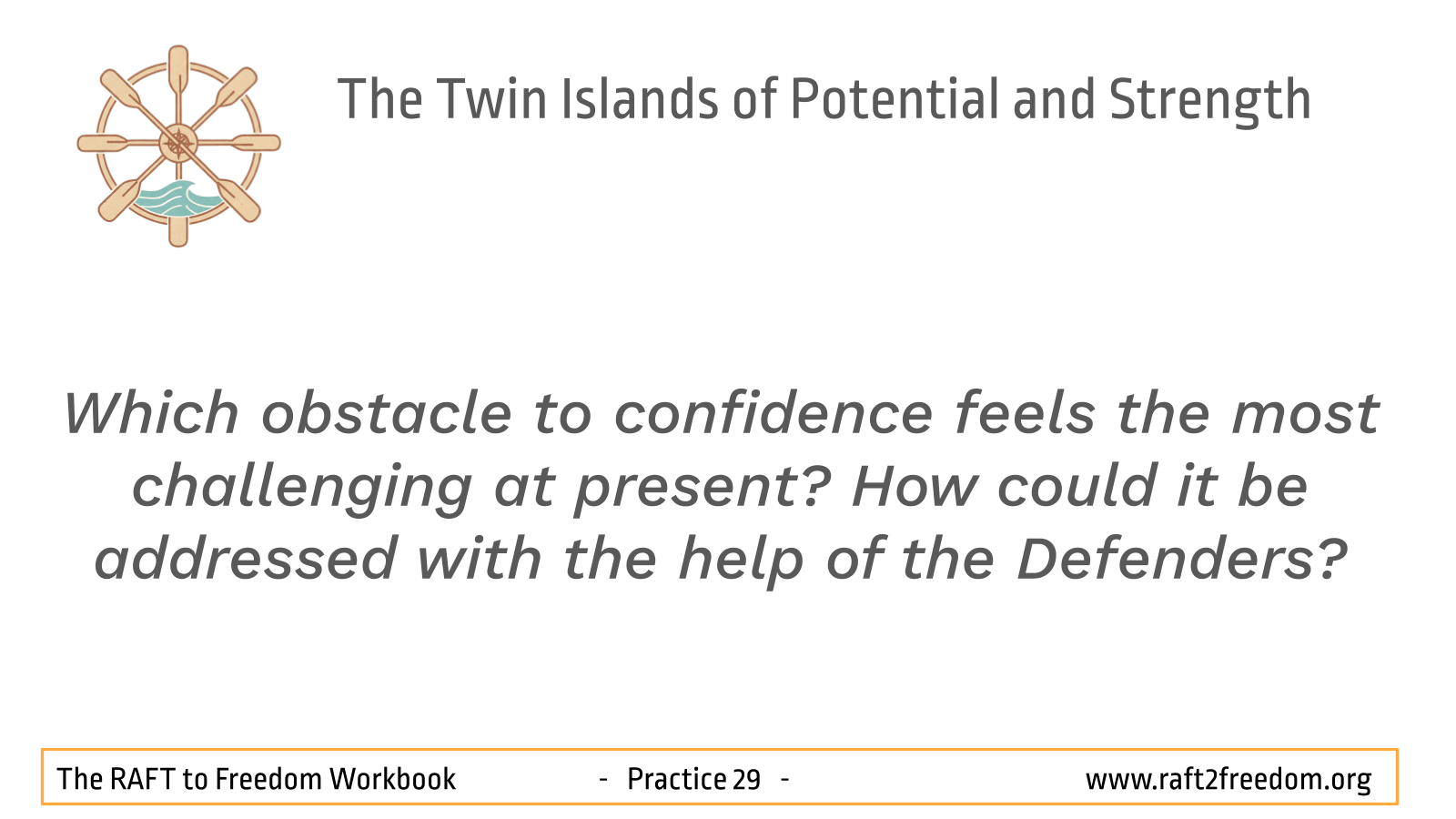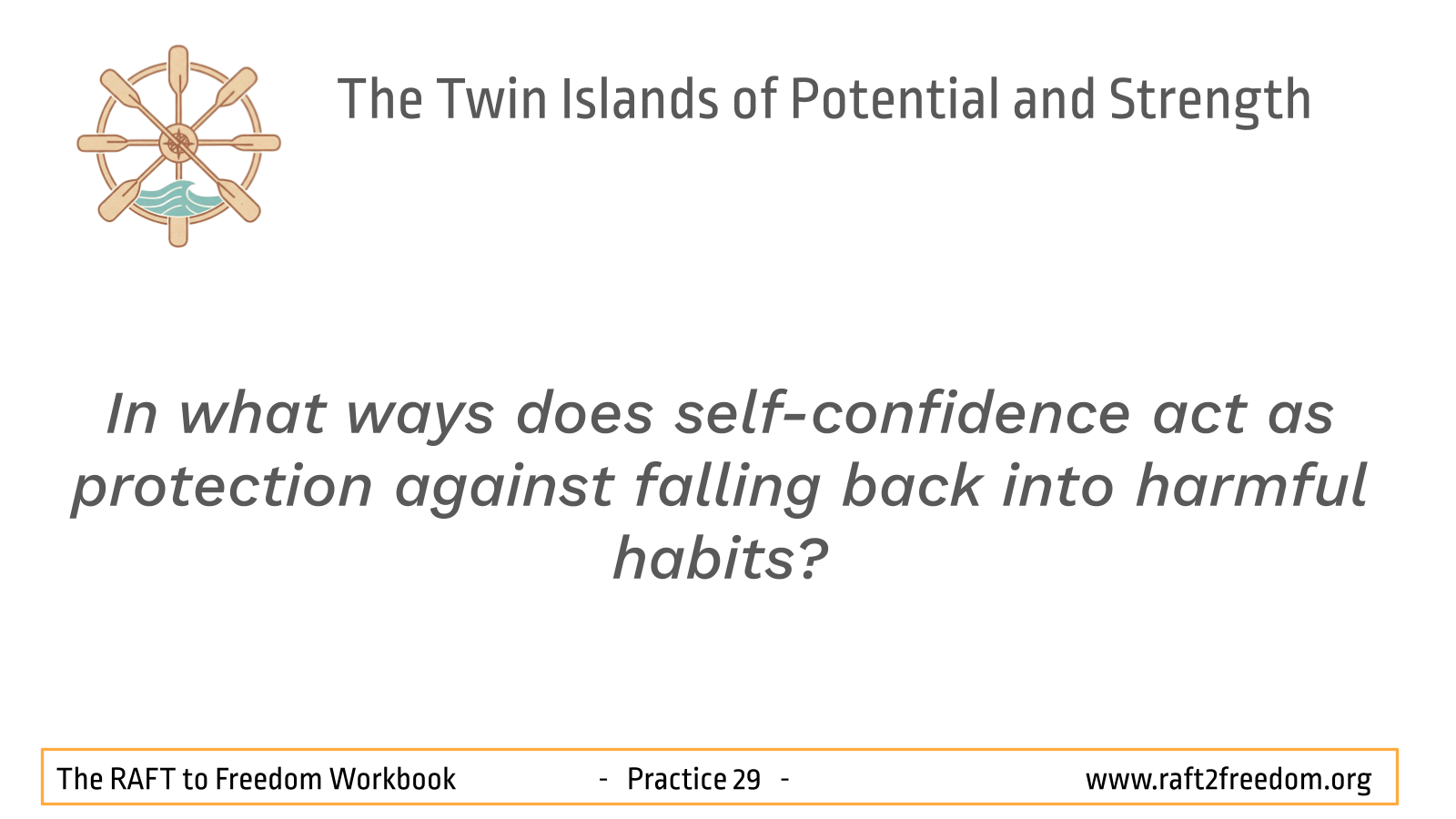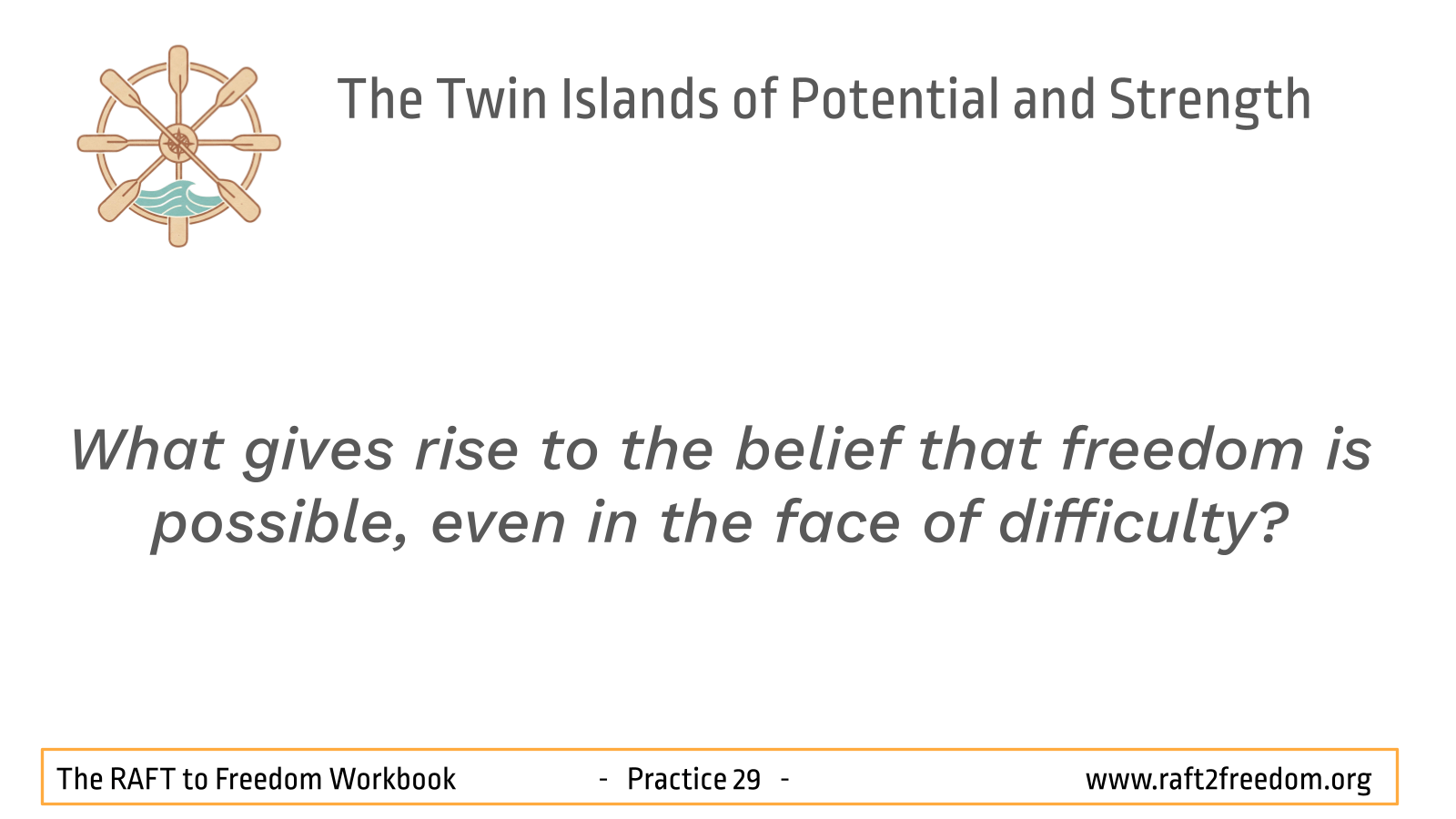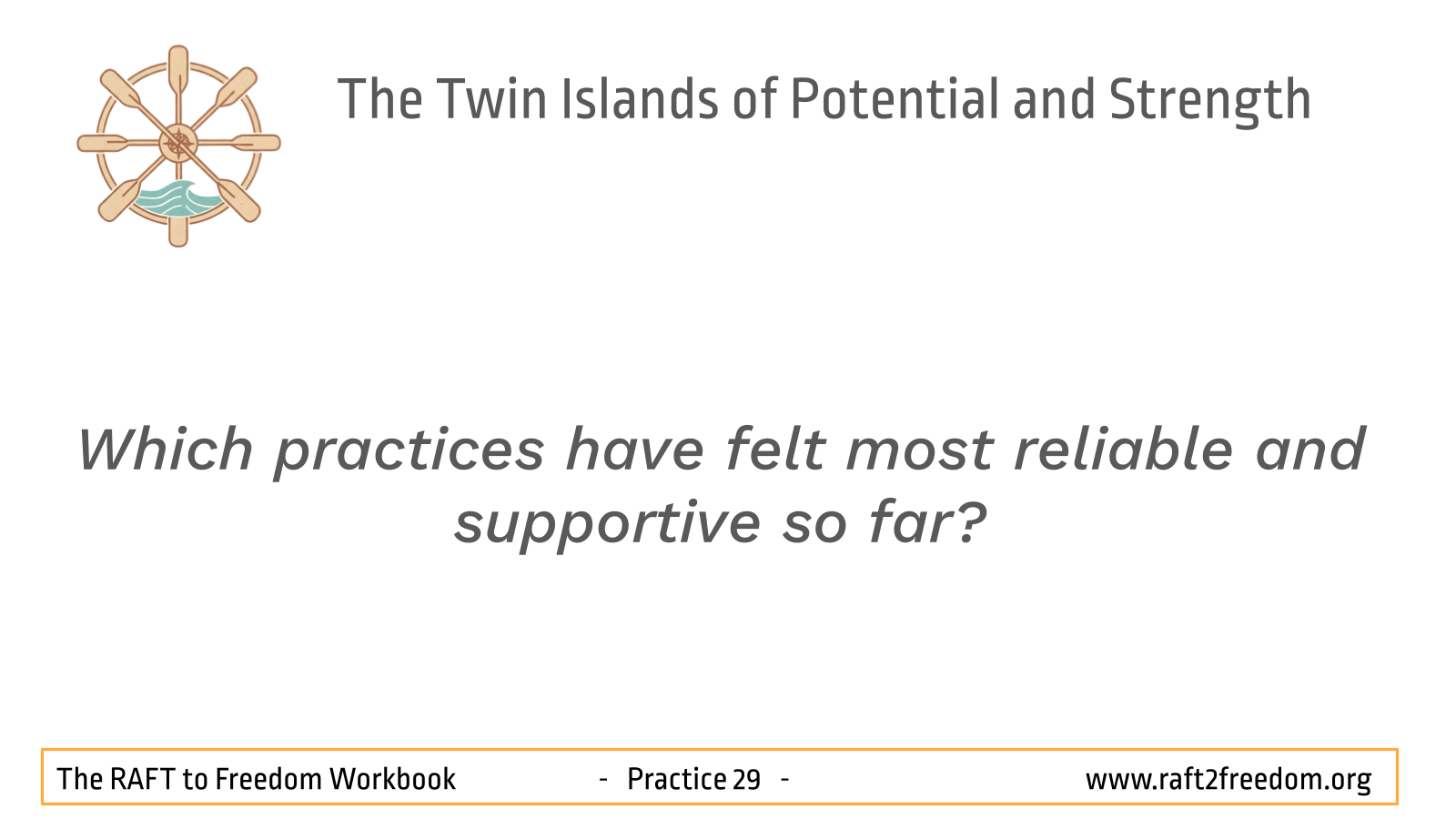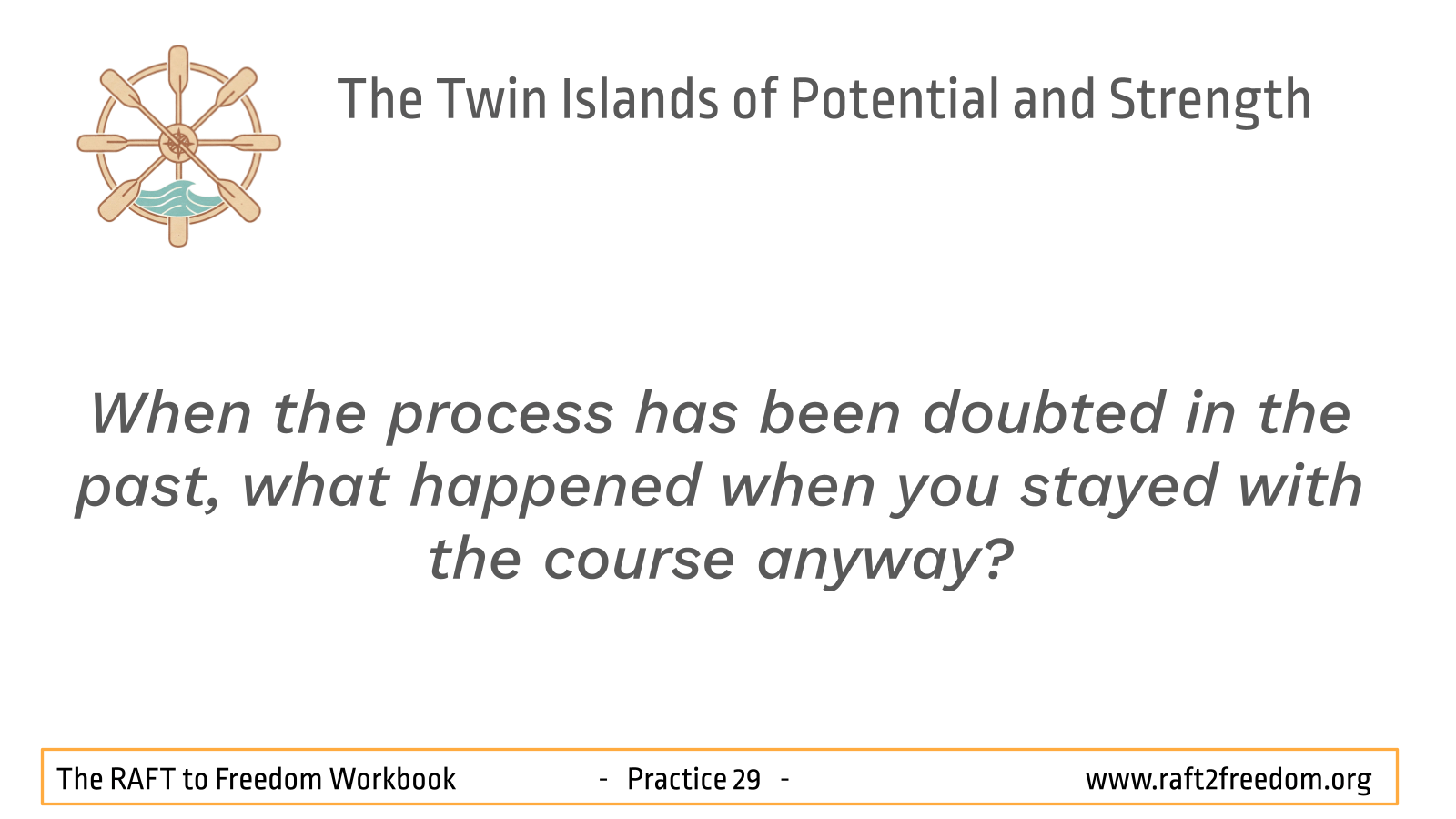29 – Confidence as a Defence
In some ways, to be a person of faith is to be a person whose life is illuminated from within. There is a guiding light… It is trans-rational, yet it speaks with utter clarity, serving as our foundational, non-negotiable value or standard.
Stephen Batchelor
Faith is taking the first step even when you don’t see the whole staircase.
Martin Luther King Jr.
Faith is the willingness to take the next step, to see the unknown as an adventure, to launch a journey.
Sharon Salzberg
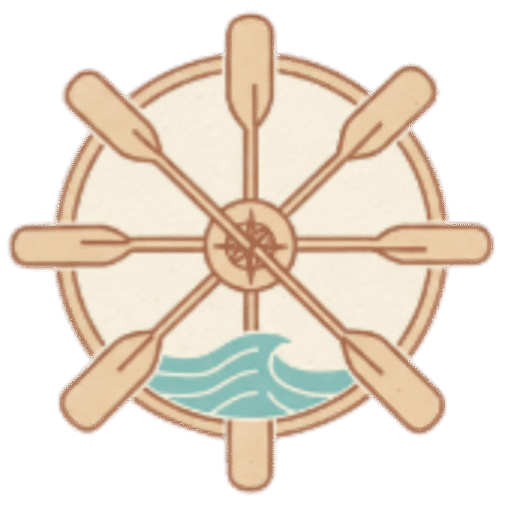
Episode 29: From faith to verified trust
An AI generated ‘deep dive’ into this aspect of the RAFT to Freedom
From faith to verified trust
As we continue the second stage of our journey – focusing on abandoning harmful cravings and compulsions – we explore the first of the ‘Five Defenders’ – Confidence (saddhā), often translated as ‘Faith’. In the context of the RAFT to Freedom workbook, this quality is far from blind belief. Instead, it is the vital inspiration, motivation, trust, and growing conviction rooted in direct experience that allows us to undertake and sustain the challenging journey from suffering to freedom. The Buddhist teacher, Bernat Font Clos describes Confidence as ‘the inspiration, the motivation, and the commitment to practice’.
The human struggle with harmful patterns of craving and avoidance often breed deep self-doubt, hopelessness, and cynicism, manifesting as thoughts like, “I can’t change,” or “Nothing works“. Confidence is the direct antidote to these patterns. It is the willingness to believe that freedom is possible, that the path is trustworthy, and crucially, that we possess the inherent capacity to heal and grow.
This Confidence directly supports the second stage of our journey, by giving us the courage and motivation needed to face and begin ‘abandoning harmful cravings and compulsions’. It also acts as a powerful defence against the hindrance of ‘Immobilising Doubt’, which can paralyse our efforts (explored in Chapter 42). In our RAFT to Freedom metaphor, Confidence is the fundamental belief in the possibility of reaching the safe shore and the trust in the design and materials of the raft – representing the teachings and practices. It is the confidence that allows us, as the combined Captain, Navigator, and Crew, to commit to building the raft and embarking on the journey across dangerous waters. Without this trust, we remain stuck on the perilous shore. Confidence keeps us oriented and committed, especially when storms of doubt, craving or aversion arise. This confidence is not static; it evolves.
Three forms of Confidence on the path
- Leaping faith (inspired confidence)
At the beginning, confidence may arise from seeing others who have already walked the path to freedom. Their flourishing lives offer living proof that transformation is possible. Even before we have personal experience, their example inspires us to believe. It is like a crowd standing before a raging river: no one dares to cross until one person leaps boldly to the far bank. Once that leap is made, fear dissolves, and others find the courage to follow. In the same way, confidence is contagious – borrowed at first from the light of others, until it begins to glow within us.
- Clarifying faith (verified confidence)
As we practise – mindfulness, ethical living, reflection, community – we begin to notice the benefits firsthand. A little more calm, a craving that passes without control, a moment of deep self-awareness. These direct experiences are like a precious gem placed in muddy water: slowly the mud settles and the water clears. Confidence shifts from inspired hope to verified trust, grounded in lived experience. This is what Gotama encouraged: “Do not believe blindly, but test it for yourself. See whether it leads to well-being.” Clarifying confidence purifies the heart of doubt and strengthens our willingness to keep going.
- Unshakable faith (stable confidence)
Over time, confidence matures into something steady and enduring. No longer dependent on the example of others, and no longer fragile in the face of setbacks, it becomes an inner refuge. This unshakable trust is not naïve certainty, but a grounded knowing: “I have walked this far. I know from experience that freedom is possible. I will not turn back.” It is like a tree with deep roots: storms may bend its branches, but it cannot be uprooted. In the same way, unshakable confidence sustains us through difficulty and protects us from being swept away by old habits or despair.
Confidence may begin as a spark borrowed from others, but through practice it becomes a clear flame within, and finally a steady beacon that lights the way – for ourselves and for those who follow after us.
Four aspects of Confidence in our journey to freedom
Cultivating confidence is not about blind belief – it is about nurturing trust in specific areas that support wellbeing and freedom. When these aspects of confidence grow, they reinforce each other, becoming a stable foundation for our raft.
- Trust in the possibility of change: ‘Mara’ (hopelessness) can whisper, “You’ll never change.” Confidence begins when we allow ourselves to believe that freedom from harmful cravings and compulsions is possible. Even before we have proof, we can choose to be willing. Each small sign of progress – a craving resisted, a compassionate choice made – becomes evidence that change is already happening. Confidence is supported by Discernment that helps us see progress clearly, while Healing Mindfulness keeps us present enough to notice these small victories.
- Confidence in the process: It can be easy to doubt whether the practices will “work for me.” Confidence in the process grows as we test them out and witness the results. Within the RAFT framework, this includes mindfulness practices, ethical living (the Five Gifts), therapy, journaling, community support, and meditation. Each practice becomes another oar that helps us row forward. Courageous Effort supports Confidence by providing the energy to stay with the practices, while A Gathered Mind helps us return to them even when distractions pull us away.
- Self-Confidence – trusting inner wisdom: Over time, confidence deepens into trust in ourselves. We begin to see that we are capable of awareness, of making skilful choices, and of learning from experience. We no longer rely solely on external validation but draw strength from within. The moment we realise “I can do this too” is pivotal. This unshakable inner confidence is not arrogance but clarity about our own potential. Confidence is supported by Healing Mindfulness strengthens awareness of inner wisdom, and Discernment helps us trust the guidance of our own experience.
- Confidence from ethical living and harm reduction: When we live in harmony with the Five Gifts (Chapter 4), we actively reduce harm. This builds self-respect, steadies the raft, and reinforces trust in the path. Each ethical choice becomes a plank in our raft, strengthening not only our journey but also benefiting those around us – family, friends, and community. Confidence is no longer abstract; it is embodied in daily choices. Confidence itself is reinforced each time we keep an ethical commitment, while Courageous Effort supports us in choosing what is wholesome even when temptations are strong.
How to strengthen Confidence
Confidence is not something we either have or do not have – it is an active quality that can be nurtured and strengthened, like a muscle. Each choice, each practice, and each act of trust adds to the raft that carries us toward freedom.
- Engage the path with curiosity: Instead of asking, “Will this work for me?” we can ask, “What happens when I practise this?” Approaching RAFT practices – mindfulness, ethical living, journaling, meditation, community – as experiments frees us from the weight of expectation. Confidence grows naturally when the path is tested for ourselves.
- Defenders working together: Healing Mindfulness keeps us open to experience, and Discernment shows us what brings benefit.
- Affirm progress daily: Confidence strengthens when we take time to notice the steps already taken. At the end of each day, pause to note one action, however small, that supported freedom. Over time, these notes form a solid body of evidence that challenges despair and doubt.
- Defenders working together: Confidence builds directly, while A Gathered Mind supports the habit of pausing and reflecting.
- Challenge doubt and shame: Inner voices of doubt often sound like: “You can’t do this,” or “You always fail.” These thoughts can be gently met with compassion and inquiry: “Is this absolutely true? What is the evidence against it?” By challenging these voices, we loosen their hold.
- Defenders working together: Discernment exposes false beliefs, and Mindfulness stops us from automatically believing them.
“I see you, Mara”
- Anchor in ethical living: Every time we live in alignment with the Five Gifts (Chapter 4), we strengthen confidence. Ethical choices build self-respect and remind us of our capacity for skilful action.
- Defenders working together: Courageous Effort helps us make the harder but wiser choice, while Confidence grows stronger with each ethical action.
- Seek ‘Noble Friendship’: Confidence is contagious. When we spend time with people who live with integrity and hope, their presence inspires us to believe in our own potential. Supportive companions, mentors, and groups can help us stay the course.
- Defenders working together: Confidence and Courageous Effort are reinforced by the encouragement of ‘noble friends.’
- Practise courage and patience together: Sometimes courage must come before confidence. Taking a brave step – whether attending a group, riding out a craving, or speaking honestly – can spark the growth of trust. With patience, these small acts of courage accumulate into lasting confidence.
- Defenders working together: Courageous Effort provides energy for the first step, and patience with A Gathered Mind sustains the journey.
- Remember the possibility of change: Reflecting on times when change seemed impossible but happened anyway anchors confidence in reality. Transformation is not only possible – it has already occurred in your life.
- Defenders working together: Discernment and Mindfulness recalls lessons learned, and Confidence takes heart from them.
- Embrace impermanence: Remembering “This too shall pass” gives confidence to ride out difficult feelings instead of rushing back to harmful habits. Cravings and pain rise and fall like waves; they do not last forever.
- Defenders working together: Healing Mindfulness observes the changing nature of experience, while A Gathered Mind helps us wait without being swept away.
- Cultivate creative responsiveness: As the Buddhist teacher Martine Batchelor notes, confidence and faith allow creativity: instead of reacting in old ways, we can ask, “What is another, non-harmful way to respond?” Confidence is strengthened each time we discover a new possibility.
- Defenders working together: Discernment reveals alternatives, and Courageous Effort supports trying them out.
- Recognise the evolving ‘Self’: Confidence grows when we forgive ourselves for past mistakes and allow space for growth. We are not stuck with a fixed identity; we are a ‘work-in-progress’, capable of change and awakening. Each act of self-forgiveness (Chapter 66) lifts another ‘rock of shame’ from the raft.
- Defenders working together: Confidence itself deepens as we learn to see ourselves not as failures but as learners on the path.
Obstacles to Confidence — and how to overcome them
On the journey to freedom, confidence does not always come easily. It is natural to meet obstacles along the way. Recognising these challenges and knowing how to work with them turns obstacles into stepping stones.
Self-doubt: Sometimes we feel weighed down by memories of past failures or by the inner voice (Mara) that says, “You’ll never succeed.” This doubt can erode confidence before we even begin.
| How to overcome: Gently notice these thoughts without believing them. Keep a progress journal and record even small wins each day. Over time, these entries become real evidence that you are moving forward. When the inner critic speaks, answer it with facts: “Yes, I’ve stumbled, but I also kept going. Here is the proof.” | Defenders to call on: Mindfulness helps us catch self-critical thoughts as they arise, while Discernment reminds us they are only mental habits, not truths. |
Fear of failure – abandoning ship: Fear whispers that setbacks mean you should give up, or that leaving behind old habits – even painful ones – will be too hard. This fear can make you want to retreat into what is familiar.
| How to overcome: Reframe setbacks as lessons, not proof of inadequacy. Just as a sailor learns from every storm, each difficulty teaches resilience. Practice self-compassion: speak to yourself as you would to a close friend. Remember, recovery is about progress, not perfection. | Defenders to call on: Courageous Effort gives us the energy to keep going despite fear, while A Gathered Mind helps us stay steady and not scatter when things feel overwhelming. |
Mistrust of the process: Skepticism can arise: “Will these practices really work for me?” or “Maybe I’m different, maybe nothing will help.” This mistrust can block engagement with the very tools that support freedom.
| How to overcome: Approach the practices with open curiosity, as suggested in the Kalama Sutta. Trust your own direct experience: notice even the smallest shifts that come from trying the methods. Share your doubts openly with a mentor, guide, or supportive peer, so they do not grow in silence. | Defenders to call on: Discernment allows us to see clearly whether the practices are bringing benefit, and Confidence grows naturally when we test the tools for ourselves and see results. |
Negative influences and environments: Confidence is fragile when we are surrounded by cynicism, criticism, or environments that do not support growth. Old companions or familiar places can pull us back toward patterns we are trying to release.
| How to overcome: Actively seek out ‘noble friendships’ – people who encourage, support, and inspire your growth. Choose environments that strengthen your intention to recover. Where possible, reduce time spent with people or places that undermine your confidence. | Defenders to call on: Mindfulness makes us more aware of harmful influences, Discernment helps us choose wisely, and Courageous Effort gives us the strength to step away from negativity and step toward supportive connections. |
Remember to remember: Obstacles are not roadblocks but part of the path itself. Each challenge faced and worked through builds a deeper, steadier confidence – the kind that does not waver in the winds of craving or doubt. And each of the Five Defenders stands beside you, ready to support confidence when it is tested
Self-reflections
Use these questions to pause and look inward. They are not problems to solve but invitations to explore your living relationship with confidence and trust.
- What most inspires confidence in the journey to freedom right now – a practice, a person, a past success, or an insight?
- Where do doubt or hopelessness arise most strongly, and what patterns can be observed around them?
- How deep is trust in the process of this path, even when it feels slow or difficult?
- How much confidence is felt in your own capacity for wise choices, learning, and growth? What supports this self-trust – and what undermines it?
- https://raft2freedom.org/wp-content/uploads/2025/08/Practice_29_The_Twin_Islands_of_Potential__6.png
- When have you surprised yourself by being stronger or more resilient than you believed?
- What small signs of change have already been noticed? How do they affect confidence?
- Which obstacle to confidence feels the most challenging at present? How could it be addressed with the help of the Defenders?
- In what ways does self-confidence act as protection against falling back into harmful habits?
- What gives rise to the belief that freedom is possible, even in the face of difficulty?
- Which practices have felt most reliable and supportive so far?
- When the process has been doubted in the past, what happened when you stayed with the course anyway?
Journaling prompts
Writing makes inner experience visible. Use these prompts to deepen your confidence.
- Sources of inspiration: Write about a person, story, or teaching that gives rise to hope. Which qualities inspire you, and how might you nurture those same qualities within yourself?
- Evidence log: Keep a running list of small wins, moments of clarity, or skilful choices this week. At week’s end, review the list. How does it shift your perspective on progress?
- Working with doubt: When doubt arises, write down the exact words or feelings. Then write down counter-evidence that challenges them. What happens when both sides are seen together?
- Trusting experience: Choose one practice (mindfulness, journaling, community, therapy). Describe in detail one benefit you’ve directly experienced. How does writing this encourage trust in the practice?
- Affirming confidence: Create a personal affirmation such as “Change is possible” or “I trust my capacity to grow.” Write it daily for a week. What do you notice about its impact on your outlook?
- Moments of strength: Recall a time you met difficulty without falling back into harmful habits. Describe what you did and what inner resources supported you. What does this memory reveal about resilience?
- Confidence in connection: Reflect on a time when community, friendship, or mentorship strengthened your confidence. How did their encouragement change your view of yourself?
- Facing setbacks: Write about a recent setback. How could it be reframed as a lesson rather than a failure? What strengths did you discover in staying the course?
- Ethical choices: Record one ethical choice you made this week that built self-respect. How does this choice act as another plank in your raft?
- Creative responsiveness: Describe a moment when you responded differently than usual – more creatively, less reactively. What new possibilities opened from that choice?
- Evolving ‘Self’: Write about how you are different now compared to a year ago. What does this show you about your capacity for growth and change?
- Impermanence in action: Journal about a craving, feeling, or difficulty that eventually passed. How might this memory give you confidence to hold steady through future waves?
Supporting Material: scientific and philosophical perspectives
For those interested in the scientific and philosophical underpinnings of Confidence as a Defence, the following overview highlights some key connections.
- Neuroscience: Confidence is not just a feeling; it shapes the brain. The placebo effect powerfully demonstrates how belief and expectation (confidence-like qualities) can trigger real physiological changes, including the release of endogenous opioids and dopamine, influencing pain perception and motivation. Trust is linked to neurochemicals like oxytocin, which fosters trust and connection, reinforcing the confidence we feel in supportive relationships. Hope and positive outlook engage brain circuits associated with reward and resilience, potentially buffering against stress and depression. Neuroplasticity provides a biological basis for confidence in change – the brain can rewire itself. This means confidence in the possibility of change is biologically justified: each time we practice, we literally reshape the brain towards freedom.
- Psychology: Self-Efficacy Theory (Albert Bandura) posits that belief in one’s ability to succeed (confidence in oneself) is a primary determinant of behaviour change. People who believe they can succeed are more likely to persist, recover from setbacks, and try again. Hope Theory (C.R. Snyder) emphasises goal-directed thinking and perceived pathways to success, explaining that hope combines clear goals, belief in pathways to achieve them, and the motivation to act. The therapeutic alliance, built on trust between client and therapist, is a major predictor of positive outcomes. Exposure to role models (vicarious learning) is known to build self-efficacy. Learned helplessness is the psychological counterpart to the lack of confidence. All these findings mirror the Buddhist teaching that confidence provides the inner fuel for practice.
- Philosophy: Philosophy frames confidence as a courageous commitment in the face of uncertainty. Epistemology debates the role of faith and trust alongside reason and empirical evidence in acquiring knowledge. Existentialism often involves a ‘leap of faith’ – committing to values or a path despite inherent uncertainty. Secular philosophers like Stephen Batchelor emphasise faith as commitment to this life and its suffering, rather than belief in transcendent powers. He frames it as a commitment to responding to the suffering of life here on earth, becoming the driving force of practice. Martin Hägglund describes this as “the confidence that life is worth living,” which is intrinsic to all forms of care. The commitment aspect of confidence relates to philosophical concepts of will and resolve. These perspectives echo Gotama’s teaching that confidence is not about blind belief, but about acting on trust and verifying truth through experience.
Remember to remember
Confidence, the First Defence of Freedom, is far more than wishful thinking. It is the steady trust that becomes our first line of defence against despair and doubt. Just as a sailor must believe in the strength of their vessel before setting out to sea, so too must there be trust in your raft and the capacity to steer it. Without this trust, a launch from the dangerous shore would never happen. With it, the courage is found to face uncertainty, craving, and fear with resilience.
Stephen Batchelor suggests it is an inner light that illuminates our path and gives us the courage to take the first step and keep going. At first, this confidence may appear fragile, borrowed from the inspiration of others who have walked this path before us – mentors, companions, or those who have found freedom. Over time, through diligent effort and direct experience, it matures into something unshakable: a tested trust that no storm of craving or doubt can sink. Each time a skilful choice is made, a difficult craving is sat with, harmful urges are resisted, or life is lived in harmony with the Gifts, another plank of confidence is laid down in our raft.
Confidence is not blind faith; it is the lived experience that the path works, that change is real, and that freedom is possible. Remember to remember that confidence is already present. It is the inner light that ignites Courageous Effort, supports Healing Mindfulness, steadies the Gathered Mind, and opens the door to Discernment. Nurturing confidence is nurturing the very heart of the journey to freedom, ensuring our raft is launched with purpose and trust. When doubt arises, there can be a return to the truth that the raft is trustworthy, the path is trustworthy, and the capacity to heal is present.
A person with confidence seeks what is skillful, associates with the wise, lives ethically, and develops wisdom.
Gotama
Faith is what allows us to take the next step when we don’t yet see the whole path.
Sharon Salzberg
Sutta References
- Indriya-Vibhaṅga Sutta (SN 48.10) – The Analysis of the Faculties
- Summary: This sutta provides the canonical definition of confidence (saddhā) as the first of the five spiritual faculties. It is defined as confidence placed in the awakening of the Buddha, which represents trust in the possibility of liberation and the path itself. This sutta establishes confidence as a core, trainable faculty that is foundational to the entire path of practice.
- Upanisa Sutta (SN 12.23) – Proximate Cause
- Summary: This discourse illustrates the crucial role of confidence in the causal chain leading to liberation. It shows how confidence (saddhā) is the prerequisite for gladness, which leads sequentially to rapture, tranquillity, happiness, concentration, and ultimately, to the knowledge and vision that brings freedom. This shows that confidence is not a passive belief but an active, essential ingredient that initiates the entire transformative process.
- Kalama Sutta (AN 3.65) – To the Kalamas
- Summary: In this famous discourse, Gotama advises against accepting teachings based on authority or tradition alone. He encourages personal investigation to see for oneself what leads to well-being and what leads to harm. This sutta provides the canonical basis for the chapter’s emphasis on ‘verified confidence’ over blind faith, validating the RAFT workbook’s approach of grounding trust in direct, personal experience.
- Sariputta Sutta (SN 55.5) – Stream-entry
- Summary: This discourse defines the stage of ‘stream-entry’ – a point of irreversible progress on the path – as being marked by unshakable confidence in the possibility of awakening (the Buddha), the path (the Dharma), and the community (the Sangha). This Illustrates how confidence evolves from a helpful starting point into the very hallmark of profound and lasting transformation and stability, by overcoming doubts and committing to the path.
| RAFT to Freedom © 2025 by Dr Cathryn Jacob and Vince Cullen is licensed under CC BY-NC-SA 4.0. To view a copy of this license, visit https://creativecommons.org/licenses/by-nc-sa/4.0/ |
